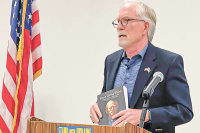State, counties play hot potato over teacher salaries
Stagnating pay for North Carolina teachers is prompting some local school leaders to dig a little deeper for salary bonuses at the county level.
Jackson County suspended its local salary bonus for teachers about five years ago amid state budget tightening. Now, the school system is not only bringing back the 2 percent salary bonus from pre-recession days, but upping it to 3 percent.
“We feel like it is time to reinstate that,” said Jackson School Board Chairman Ken Henke, a retired principal. “We feel our teachers have waited patiently.”
Nearly every county forks over a small bonus for teachers that’s tacked on top of the base salary paid by the state. Known as supplements, they range from 1 percent to upwards of 14 percent, depending on the county.
“Since the state hasn’t given any raises it makes the counties compete with each other even more,” said Haywood County Commissioner Bill Upton, a retired superintendent and principal.
Related Items
The issue is more acute for Haywood, which borders Buncombe and Asheville school districts, where supplements are as much as 10 percent, Upton said.
“People don’t have to drive very far to get to Buncombe,” Upton said.
But supplements are an important recruitment and retention tool wherever you are, said Jackson County School Superintendent Mike Murray.
“We are in competition with every other system,” Murray said. “It is a beautiful place to live, and I can draw some folks in with that, but a beautiful place to live doesn’t pay your bills.”
Jackson County is also rolling out $1,000 signing bonuses for newly-hired teachers.
The budget climate is not exactly conducive for increases to teacher supplements, however. State cuts to education have forced school systems to plug the hole with local money they get from county coffers.
“If we lose state money, we have to replace that with local money,” said Jerry McKinney, school board member in Swain County.
And that means less local money to go around for supplements. Swain currently doesn’t have teacher supplements — one of the few counties in the state without them. But when Swain school leaders go hat in hand to county commissioners next month to ask for more local funding for schools, supplements will be but one request on a long list.
Public education cuts have become an albatross around the necks of state Republican leaders — particularly in the area of teacher salaries. North Carolina has fallen to 49th nationwide in teacher pay. Democrats have hammered that message home every chance they get, blaming Republicans for the bad ranking.
Last month, Gov. Pat McCrory said he wants to find money for teacher raises. He called on the state legislature to join him in crafting a raise package for teachers when the General Assembly reconvenes later this spring.
“The number one thing we are going to be talking about is education,” said N.C. Rep. Michele Presnell, R-Burnsville. Presnell said she will support teacher raises. The state would have given teacher raises last year, if not for Obamacare, she said.
“We cannot help education until we get a handle on Medicaid. Obamacare has thrown all these additional people in there,” Presnell said. “That is the problem with giving educators more of a raise.”
However, the real culprit sucking up state education money was the billion dollars in tax breaks that primarily benefited the wealthy, according to Rep. Joe Sam Queen, D-Waynesville.
“That came right out of the budget for education, community colleges and our universities,” Queen said.
Queen is suspicious of the true motive behind the proposed raises in a state election year.
“The timing stinks of political posturing, and the teachers see it,” Queen said. “But it is high time. The system needs good teachers, and you have to pay them well to attract them and keep them.”
Major budget maneuvers — like raises for more than 95,000 teachers on the state payroll — are unusual in the General Assembly’s “short session” that occurs every other year.
The last time teacher raises were handed out, they likewise came right before state elections.
“It was a 1.2 percent pay raise, just prior to the November elections. I wonder why they did it then?” posed Dr. Bill Nolte, assistant superintendent of Haywood County Schools.
Teacher salaries had flat-lined for several years prior, so that modest bump in 2012 was a token bump at best.
And it was a double-edged sword.
While teachers got a modest raise from the state that year, education overall has been cut.
“Our concern is they are slowly bleeding us to death,” Nolte said. “My message to the General Assembly is to stop the cuts first.”
Nolte said per pupil education funding has been cut year over year for five years.
“No one with the General Assembly and Governors office have said the cuts will stop,” Nolte said. So to him, the conversation is bigger than teacher salaries.
Schools have bigger class sizes, fewer teacher assistants and less money for teaching supplies despite the new, more rigorous statewide curriculum and testing regimens, he said.
Jackson’s supplement
Current status: Historically 2 percent, but suspended indefinitely five years ago.
Future outlook: To be reinstated — plus some — in the coming year, at a level of 3 percent.
Annual cost to county: $700,000 for 3 percent.
The return of teacher salary supplements in Jackson comes with a caveat. They are only guaranteed for the coming school year and will be up in the air again after that. Supplements for the coming year will be paid out of reserves, using money the school system has built up in savings over the past couple of years.
But it’s not sustainable long-term.
“We would like to continue if we could, but don’t know if we would be able to,” said Gwen Edwards, Jackson school finance director.
The school system would likely need more money from the county to keep up the supplements beyond the coming year.
Money that used to go to teacher supplements in Jackson was redirected to plug recession-driven budget cuts.
“It wasn’t that we wanted to neglect them,” said Henke. “We told them we just don’t have the money.”
As state funding dropped, school systems were forced to lay off teachers, increase class size, do away with teacher assistants for all but kindergarten and first grade, and scale back on anything deemed “extra,” from computer lab teachers to music teachers.
In Jackson County, money that used to go toward local salary bonuses was spent keeping teachers on the payroll who otherwise would have been let go.
“We had been rolling that into general expenses to try to keep the ship floating,” Murray said.
Teachers accepted the reality stoically.
“We didn’t hear one complaint,” Edwards said.
Haywood’s supplement
Current status: 4 percent on top of state base pay, with an extra half a percent for teachers with 20 or more years on the job and an extra 1 percent for teachers with 25 or more years. For all certified school system employees.
Future outlook: Likely steady at the helm, but there is support from one county commissioner for an increase.
Annual cost to county: $1.5 million for the current supplement formula.
Haywood County commissioners, in partnership with the school system, adopted a new teacher supplement scale in the mid-2000s, with the goal of inching them up a bit year over year. The supplement is the highest of the seven western counties.
“We got it there before the budgetary cuts began, and we have worked very, very hard not to lose it because we are fearful we would not get it back, and we were also fearful we would lose teachers to surrounding districts,” said Nolte, assistant superintendent.
Haywood must compete with its next-door neighbors of Buncombe, Henderson and Asheville City schools.
“People west of us may not compete with them because of the distance, but we border those,” Nolte said.
To increase the supplement any, the county would need to pony up more money.
“That is something I would like to look at,” Haywood Commissioner Bill Upton said. “It has been quite a period of time since we have done anything with supplements.”
Upton first mentioned the idea during a budget work session of commissioners in February. He later asked the school system for estimates of what it would take. To increase it by half a percent, it would cost $163,000.
“What I would like to look at is at least doing a quarter percent. We need some kind of plan where we incrementally increase that supplement,” Upton said.
Macon’s supplement
Current status: 2 percent supplement, paid out as a one-time bonus in November, for teachers only.
Future outlook: No change likely.
Annual cost to county: More than $400,000.
The modest supplement for teachers in Macon County was nearly swallowed up to plug a budget shortfall faced by the school system this year. School leaders had asked the county for permission to reallocate the teacher supplement for general operations if need be.
And permission was granted, but in the end, the school board passed the bonuses out as it always does — in a one-time lump sum in November’s paycheck, conveniently timed before Christmas shopping.
There was one piece of the supplements missing this year, however.
They only went to teachers, teacher assistants and principals — none of the directors in central office got them as they had in the past, according to Angie Cook, finance officer for Macon Schools.
Swain’s supplement
Current status: No supplements for teachers, but bonuses of $4,000 to $8,000 for principals and assistant principals.
Future outlook: Iffy for any movement on teacher supplements.
Annual cost to county: Around $30,000.
Swain County is one of only about 10 school districts statewide that don’t pay teacher supplements.
In fact, when it comes to per pupil education funding from the county, Swain ranks dead last, according to the annual assessment by Public School Forum of North Carolina. The ranking measures total local education funding from county coffers.
Historically, the Swain County school board hasn’t come out and directly asked county commissioners to increase local school funding. School leaders are usually quick to sympathize with Swain County’s plight as a poor, small, rural county with little money to spare.
“We are trying to get funding out of a source that doesn’t have a lot of money to begin with,” said Jerry McKinney, school board member.
But if you never ask, you’ll never get it. And so this year, the Swain school board will, for the first time in recent history anyway, directly and publicly ask county commissioners for more money for schools.
“Yes, we are going to try to,” McKinney said.
The school board is meeting with county commissioners in coming weeks to talk budget.
Teacher supplements are one thing on the table, but they are probably not at the top of the list.
For example, Swain has just one guidance counselor serving 650 high school students — which isn’t enough given the county’s goal of reducing drop-outs and steering more students toward college. The school system also hopes to start intensive summer programs to help low-performing students catch up.
And, the school system wants to take on STEM instruction, a.k.a. Science, Technology, Engineering and Math.
“If we do a STEM initiative, you aren’t talking about just text books. The high-tech equipment and programming is much more expensive than what you had 40 years ago with a book, paper and pencil,” Swain Superintendent Sam Patillo said.
And the big kicker is a growing student body causing a space crunch at some schools.
Patillo said the school system will put everything “on the table” with commissioners, and ask them what they are willing to fund.
“We are trying to do a collaborative effort,” Patillo said.
Ultimately, the county’s residents and taxpayers need to do some soul-searching over what they are willing to invest in education, Patillo said, and whether the culture that’s led to low funding for education can be reversed.
“What are our citizens willing to do to get this? We all have to come to a consensus on what that is,” Pittillo said.
“The bottom line is it takes resources to improve education. It would help kids,” McKinney added.









